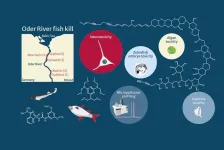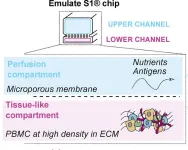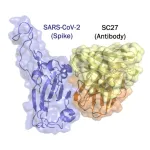(Press-News.org) A new study led by Rice University’s Qimiao Si has unveiled a new class of quantum critical metal, shedding light on the intricate interactions of electrons within quantum materials. Published in Physical Review Letters on Sept. 6, the research explores the effects of Kondo coupling and chiral spin liquids within specific lattice structures.
“The insights gained from this discovery could lead to the development of electronic devices with extreme sensitivity, driven by the unique properties of quantum-critical systems,” said Si, the Harry C. and Olga K. Wiess Professor of Physics and Astronomy and director of Rice’s Extreme Quantum Materials Alliance.
Quantum phase transitions
At the core of this research is the concept of quantum phase transitions. Just as water changes between solid, liquid and gas states, electrons in quantum materials can shift between different phases as their environment changes. But unlike water, these electrons follow the rules of quantum mechanics, leading to much more complex behaviors.
Quantum mechanics introduce two key effects: quantum fluctuations and electronic topology. Even at absolute zero where thermal fluctuations disappear, quantum fluctuations can still cause changes in the organization of electrons, leading to quantum phase transitions. These transitions often result in extreme physical properties known as quantum criticality.
Moreover, quantum mechanics give electrons a unique property tied to topology, a mathematical concept that when applied to electronic states can produce unusual and potentially useful behaviors.
The study was carried out by Si’s group in a long-term collaboration with Silke Paschen, study co-author and a professor of physics at the Vienna University of Technology, and her research team. Together they developed a theoretical model to explore these quantum effects.
The theoretical model
The researchers consideredtwo types of electrons: some moving slowly, like cars stuck in traffic, and others moving quickly in a fast lane. Although the slow-moving electrons appear stationary, their spins can point in any direction.
“Ordinarily, these spins would form an orderly pattern, but the lattice they inhabit in our model doesn’t allow for such neatness, leading to geometrical frustration,” Si said.
Instead, the spins form a more fluid arrangement known as a quantum spin liquid, which is chiral and picks a direction in time. When this spin liquid couples with the fast-moving electrons, it has a topological effect.
The research team discovered that this coupling also triggers a transition into a Kondo phase, where the spins of the slow electrons lock onto the fast ones. The study reveals the complex interplay between electronic topology and quantum phase transitions.
Usual electrical transport
As electrons move through these transitions, their behavior changes dramatically, particularly in how they conduct electricity.
One of the most significant findings is about the Hall effect, which describes how an electrical current bends under the influence of an external magnetic field, Paschen said.
“The Hall effect contains a component that is enabled by the electronic topology,” she said. “We show that this effect experiences a sudden jump across the quantum critical point.”
Implications for future technology
This discovery advances our understanding of quantum materials and opens up new possibilities for future technology. An important part of the research team’s finding is that the Hall effect responds drastically to the quantum phase transition, Si said.
“Thanks to the topology, this response happens in a minute magnetic field,” he said.
The unusual properties could lead to the development of new types of electronic devices such as sensors with extreme sensitivity that could revolutionize fields like medical diagnostics or environmental monitoring.
Co-authors of the study include Wenxin Ding of Anhui University in China, a former postdoctoral fellow in Si’s group at Rice, and Rice alumna Sarah Grefe ’17 of California State University.
The research was supported by the U.S. National Science Foundation, the Air Force Office of Scientific Research, the Robert A. Welch Foundation and a Vannevar Bush Faculty Fellowship.
END
Researchers advance new class of quantum critical metal that could advance electronic devices
2024-09-06
ELSE PRESS RELEASES FROM THIS DATE:
DOE, ORNL announce opportunity to define the future of high-performance computing
2024-09-06
The U.S. Department of Energy’s (DOE) Office of Science (SC) today announced a new research and development opportunity led by Oak Ridge National Laboratory (ORNL) to advance technologies and drive new capabilities for future supercomputers. This industry research program worth $23 million, called New Frontiers, will initiate partnerships with multiple companies to accelerate the R&D of critical technologies with renewed emphasis on energy efficiency for the next generation of post-exascale computing in the 2029 ...
Cannabidiol demonstrated to alleviate symptoms of Leigh syndrome
2024-09-06
A study led by the UAB Institut de Neurociències and published in the journal Nature Communications demonstrates in animal models how daily administration of cannabidiol (CBD), a substance obtained from the cannabis plant, extends lifespan and improves symptoms associated with Leigh syndrome. This severe mitochondrial disease affecting children is characterised by a progressive decline in cognitive and motor functions and premature death. The research group also demonstrated in both mice and fibroblasts from children with ...
A chemical cocktail of micropollutants amplified the effect of algal toxins causing mass fish mortality on the River Oder in 2022
2024-09-06
Summer 2022’s environmental disaster led to the death of up to 60 per cent of fish biomass and up to 85 per cent of mussel and snail biomass in the River Oder. In August 2022, the UFZ set up an interdisciplinary ad hoc working group together with researchers from the Leibniz Institute of Freshwater Ecology and Inland Fisheries (IGB), the University of Veterinary Medicine, Vienna (Vetmeduni) and the University of Birmingham. They took water samples at five locations along the Oder, extracted poisoned ...
Generative AI in cancer imaging: revolutionizing detection & diagnosis
2024-09-06
“This editorial explores its impact on expanding datasets, improving image quality, and enabling predictive oncology.”
BUFFALO, NY- September 6, 2024 – A new editorial was published in Oncotarget's Volume 15 on September 4, 2024, entitled, “Generative AI in oncological imaging: Revolutionizing cancer detection and diagnosis.”
Generative AI is revolutionizing oncological imaging, enhancing cancer detection and diagnosis. This editorial explores its impact on expanding ...
Disparity in access to medications for opioid use disorder persist in criminal legal settings
2024-09-06
EMBARGOED FOR RELEASE UNTIL 11 A.M. ET FRIDAY, SEPTEMBER 6. 2024
Individuals involved in the criminal legal system have a high rate of opioid use disorder (OUD) and a high risk of overdose death compared to the general population, yet the most effective treatments—medications for opioid use disorder (MOUD)—are underutilized in criminal legal settings where treatment is mandated as part of a person’s probation or parole. Medications are often not provided due to stigma or lack of adequate funding for evidence-based care. According to a study ...
Age-related changes in male fibroblasts increase treatment-resistant melanoma
2024-09-06
Age-related changes in the fibroblasts, cells that create the skin’s structure, contribute to the development of aggressive, treatment-resistant melanoma in males, according to research in mice by the Johns Hopkins Kimmel Cancer Center.
The study was published online Sept. 6 in Cell.
The risk of developing melanoma, a potentially deadly skin cancer, increases with age. Men are more at risk than women, and tend to develop more aggressive, hard-to-treat melanomas, particularly at advanced ages, says Ashani Weeraratna, Ph.D., the Bloomberg ...
COVID-19 and rates of cancer diagnosis in the US
2024-09-06
About The Study: This population-based cross-sectional study of U.S. cancer incidence trends found that rates of diagnosis improved in 2021 but continued to be lower than expected, adding to the existing deficit of diagnosed cases from 2020. Particular attention should be directed at strategies to immediately increase cancer screenings to make up lost ground.
Corresponding Author: To contact the corresponding author, Krystle A. Lang Kuhs, PhD, MPH, email krystle.kuhs@uky.edu.
To access the embargoed study: Visit our For The Media website at this link https://media.jamanetwork.com/
(doi:10.1001/jamanetworkopen.2024.32288)
Editor’s Note: Please see ...
New research from Swansea University shines a light on how solar power and farming can coexist
2024-09-06
Scientists from Swansea University have developed a new tool to help identify optimal photovoltaic (PV) materials capable of maximising crop growth while generating solar power.
In a recent study published in Solar RRL, academics from the University’s Department of Physics have been exploring the effect of semi-transparent PV materials placed over crops – an exemplary application of agrivoltaics (solar panels combined with agricultural settings).
As part of this work, the team has developed an innovative freeware tool that predicts the light transmission, absorption, and power generation of different PV materials nearly anywhere on the globe using ...
Artificial lymphoid organs could help predict efficacy of booster vaccines
2024-09-06
Researchers at the Institut Pasteur in France have developed artificial “lymphoid organ-chips” that recreate much of the human immune system’s response to booster vaccines. The technology, described in an article to be published September 6 in the Journal of Experimental Medicine (JEM), could potentially be used to evaluate the likely effectiveness of new protein and mRNA-based booster vaccines for COVID-19 and other infectious diseases.
The rapid mutation and evolution of SARS-CoV-2 and other viruses ...
One antibody to neutralize them all?
2024-09-06
SAN ANTONIO -- A monoclonal antibody appears effective at neutralizing the numerous variants of SARS-CoV-2, as well as related viruses in animals that could pose a threat if they were to begin spreading in people. The antibody, called SC27, was recently described in Cell Reports Medicine.
The finding opens the possibility of broader, more effective treatments to work against current and future COVID variants.
Monoclonal antibody SC27 was identified, developed and provisionally patented by a team of researchers led ...








